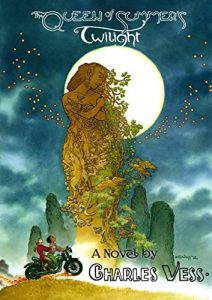Archita Mittra Reviews The Queen of Summer’s Twilight by Charles Vess
 The Queen of Summer’s Twilight, Charles Vess (NewCon 978-1-914953-27-9, £12.99, 262pp, tp) September 2022. Cover by Charles Vess.
The Queen of Summer’s Twilight, Charles Vess (NewCon 978-1-914953-27-9, £12.99, 262pp, tp) September 2022. Cover by Charles Vess.
Charles Vess’s award-winning illustrations have a spellbinding quality to them, but his debut novel, The Queen of Summer’s Twilight, a Tam Lin retelling richly shaded with evocative descriptions, failed to similarly bewitch this reader.
There are only a few notable adaptations of the Scottish ballad of Tam Lin – Diana Wynne Jones’s Fire and Hemlock and Pamela Dean’s Tam Lin, which are both rooted in modernity, and Elizabeth Marie Pope’s The Perilous Gard and Patricia A. McKillip’s Winter Rose, which are both set in a more magical, medieval world, in which the boundaries between the mortal and Fae realms are blurred. For his adaptation, The Queen of Summer’s Twilight, Charles Vess has chosen a straightforward portal fantasy.
It begins in the real world (Inverness, Scotland) where Janet, a young mixed-race woman, tired of her rich father’s oppressive rules, runs off with a stranger from another time (Thomas Lynn) on a vintage motorbike, after being accosted by some creeps in a deserted lane. Subsequently, much of the action quickly shifts to the Fae realm, which is slowly decaying in the absence of its Queen. According to Thomas, the Queen’s sanity has crumbled – quite literally – with the missing parts of her mind trapped in the bodies of two mortal women – Janet and her mother, Mairi.
This explains, but doesn’t excuse, Janet’s father’s stringent security measures or why he has consigned her mother to an institution and refuses to speak of her.
On one hand, Vess is narrating a tale about healing estranged family relations; on the other, he is also trying to make Janet and Tom fall in love from the get-go, resulting in a romance that felt forced and uninspired to me. This can also be said of the characterisation here. It doesn’t help that Janet’s dark skin is repeatedly (thrice in the narrative) compared to ‘‘chocolate’’ and her physical appearance is somewhat exoticized by her lover (early on, Tom is both ‘‘surprised’’ and ‘‘delighted’’ by her ‘‘rich brown skin’’ when he gazes upon her unconscious form). Nevertheless, patient readers might still empathize with her feelings of anger towards her father or her sadness at her missing mother, even if her choice to drive off with a stranger to escape her pursuers – and implicitly trust him simply because she is arrested by his ‘‘handsome’’ appearance and old-fashioned charms – is a tad unbelievable. This might be the stuff of savior fantasies, but most women of color in real life are more likely, while navigating public spaces, to be suspicious of a mysterious white man gallantly – and conveniently – offering help in the face of danger.
This seems especially ironic given that the original Tam Lin ballad pushed for a reversal of traditional gender roles, bestowing greater agency on the female protagonist. In most versions, Janet visits an enchanted forest, plucks a double rose, and encounters Tam; soon after, she gets pregnant. Rather than giving into the dictates of patriarchal society, she takes matters into her own hands, seeks out Tam in the woods, learns of his imprisonment by the Queen of Fairies, and after a series of obstacles that she single-handedly overcomes, wins him back from the Fae. In the first half especially of Vess’s modern-day narrative, Janet keeps swooning and dramatically tumbling into Tom’s arms on every other page; though thankfully, by the end of the book, she is less of a damsel in distress, and manages to follow the clues in the original tale to rescue her love. Indeed, the latter half is peppered with rhyming stanzas from the folk song, which might help readers unfamiliar with the original to understand the series of fantastical events, but ultimately felt overbearing.
In short, The Queen of Summer’s Twilight displays some of the classic pitfalls found in the works of inexperienced writers. At times, the dialog is too theatrical, alienating at least this reader, and although I was glad that the book acknowledged the Queen’s repeated invasions of Janet’s and her mother’s minds as violations of a sort, I do wish it had delved into the trauma and after-effects of such an encounter rather than aiming for a saccharine, unconvincing happily-ever-after.
In contrast, Vess’s vision of the twilit kingdom is rendered in rich, painterly strokes. Be it the wilting, decadent rose gardens that have been abandoned by the ruler, or the effusive growth of new life following the Queen’s rebirth, his picturesque prose recalls the redolent descriptions of Robin McKinley’s fairytale retellings, recreating a magical world that is at once, timeless and strangely familiar. Yet, his artistic talents clearly shine through – leading me to wonder how this story might have fared in a different medium (such as a graphic novel), with the writing rechecked by a sensitivity reader.
Archita Mittra is a writer and artist, with a fondness for dark and fantastical things She completed her B.A (2018) and M.A (2020) in English Literature from Jadavpur University and a Diploma in Multimedia and Animation from St. Xavier’s College.
When she isn’t writing speculative fiction or drawing fanart, she can be found playing indie games, making jewelry out of recycled material, reading a dark fantasy novel, baking cakes, or deciding which new Tarot deck to buy.
She lives in Kolkata, India, with her family and rabbits.
This review and more like it in the January 2023 issue of Locus.
 While you are here, please take a moment to support Locus with a one-time or recurring donation. We rely on reader donations to keep the magazine and site going, and would like to keep the site paywall free, but WE NEED YOUR FINANCIAL SUPPORT to continue quality coverage of the science fiction and fantasy field.
While you are here, please take a moment to support Locus with a one-time or recurring donation. We rely on reader donations to keep the magazine and site going, and would like to keep the site paywall free, but WE NEED YOUR FINANCIAL SUPPORT to continue quality coverage of the science fiction and fantasy field.
©Locus Magazine. Copyrighted material may not be republished without permission of LSFF.






